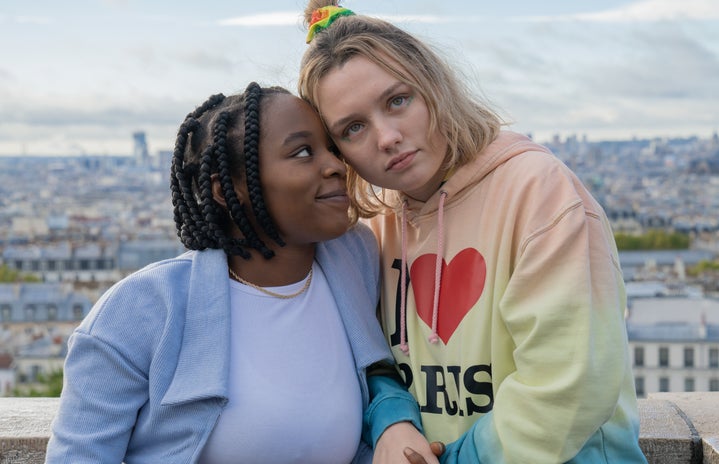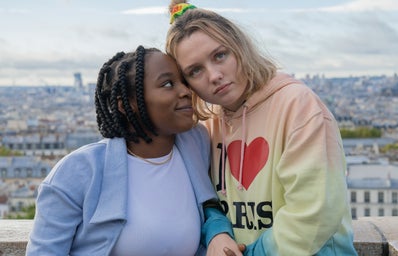When you think of LGBTQ+ media, the first films and shows that immediately spring to mind all have one glaring, testosterone-infused component in common. Call Me By Your Name, Love, Simon, Brokeback Mountain, Heartstopper, Young Royals—an overwhelming majority of the most well-known and critically-lauded queer stories of our time *just so happen* to center mlm relationships. Interesting coincidence, isn’t it?
While that is not to ignore the existence of incredible sapphic media, such as Portrait of a Lady on Fire, Carol, and, most recently, Bottoms, there can be no doubt that these films tend to receive far less hype and critical attention than their male counterparts, and they are generally less recognizable to a broader audience of moviegoers. They certainly have less cultural traction than the much-quoted “I wish I could quit you” scene, which even those who have not seen Brokeback are likely familiar with. And time and time again, they are shut out by major award shows.
Why is it that queer stories between men are so much more marketable than those between women? Why is it that the most mediocre ventures of queer male love can survive season upon season, whereas sapphic television barely manages to scrape a second one?
The past few years have not been good ones for sapphic stories. As audience members, we have witnessed beloved shows like The Owl House, The Wilds, Grease: Rise of the Pink Ladies, Willow, and A League of Their Own all get the ax, many after only one season.
These continuing occurrences can only be linked to one glaring culprit: the inherent misogyny entrenched in the entertainment industry. Because, in a hetero-patriarchal society, sapphic love is only permitted to exist in mainstream media if it satisfies the male gaze in a palatable format.
This “acceptable” representation of sapphic love takes shape in one of three ways.
First, you have “tamed” sapphic relationships which, while clearly established as canon, simultaneously lack any real physical expressions of that romance. Take Euphoria, for example. While this show’s main romance is a lesbian relationship, the portrayal of sex throughout the show is very heteronormative, featuring various graphic hetero-sex scenes, yet very scarce scenes of queer intimacy. Lesbian relationships are okay so long as viewers don’t really have to see them in too visceral of a way.
Second, there are the highly sexualized representations clearly made to appeal to a male audience, rather than the lesbian viewers they should be aiming to target. The sexualization of lesbian characters (and frequently characters who are minors!) is a major issue in longer-running shows with sapphic romances, such as Riverdale. These shows feel almost pornographic in their focus on the sexual element of lesbianism to the detriment of the actual emotional development of the relationship. The excess of sex scenes fetishizes sapphic love for the sake of attracting a male audience.
The second permitted manifestation revolves around the fact that wlw relationships can only be depicted as ancillary to a central mlm couple, because within our society’s gender hierarchy, women must always come second to men. Despite shows such as Heartstopper or Love, Victor offering valuable representation in their own rights, one can’t help but be rubbed the wrong way by the trend of lesbian relationships always taking the backseat in the narrative. This means that those characters are much more under-baked as a result. This is seen time and time again—Ola and Lily in Sex Education, Ashlyn and Maddox in High School Musical: The Musical: The Series, and most recently, Anne Bonny and Mary in Our Flag Means Death. Why can’t the lesbian characters be the main love interests? Why limit them only to subplots, or even just single episodes? Why, when they take center stage, are the shows always canceled?
A lot of this has to do with the audience. Successful queer media has a worrying trend of appealing to a straight woman gaze, who, after all, make up a sizable percentage of media consumers. What this means is that mlm movies in particular tend to cast hunky, muscular, and, for lack of a better word, “straight-passing” men for the leads—Red, White, and Royal Blue for example. Though this film is fluffy and fun and contains a sweet message, there can be no denying that both characters’ traditionally “masculine” appearance and muscular physiques inadvertently seems to cater to a straight female audience, who are usually the prime viewers of these films. Furthermore, many of the mlm films and movies I’ve mentioned regularly feature straight male actors playing the role. In other words, these films don’t always feel like they were made for the people they are intending to represent. And while it is valuable to show that queerness and ‘traditional’ masculinity can coexist, this seems to be all the representation of male queer love that we ever get. Excepting rare examples such as Glee (can’t believe I just said that, but that just goes to show how low the bar is), Sex Education, or Modern Family, queer male love rarely depicts more feminine-presenting characters. And, once again, when they do, it is in a side character role or as part of a larger ensemble cast.
This is because misogyny is one of the chief hydraheads at the root of homophobia. A man being attracted to another man is seen to make him womanly, and so he is reviled. Thus, feminine-presenting queer male characters are slighted in favor of casting leads that embody a more conventional and socially-accepted manifestation of masculinity that will also appeal to a straight female audience.
Thus, by this logic, a woman being attracted to a woman is an even more egregious offense. This is the driving force for why lesbian shows struggle so much to get off the ground: lesbian love is an utter rebuke of the patriarchal order. Sapphic love is not deemed marketable or profitable because it destabilizes patriarchy itself. Lesbian relationships at their core represent women who do not need men to experience happiness or pleasure in life, which threatens a male-centered society whose social creed espouses the exact opposite belief: that a woman must be dependent on a man. The cancellation of sapphic television only affirms the truth that no media is permitted to exist unless a man is somehow able to see himself reflected in it. Lesbian love, which has nothing to do with men, makes men—at least those who are fragile in their masculinity—feel alienated from the story, maybe even angry. This leads to the usual string of nonsense about male rights and how “if this had been the other way around, everyone would be complaining that there aren’t enough female characters.” Men cannot be content to stand on the sidelines for just one minute, long enough for wlw stories to get the recognition and amount of seasons that they deserve. Instead, the entertainment industry and audience members alike are threatened by any portrayal of romantic love that does not directly center a man.
Mlm stories have played a significant and commendable role in dismantling heteropatriarchy, as they challenge what a man can be and the roles he can inhabit. But there will always be a current of misogyny embedded in those stories so long as the entertainment industry continues to one-sidedly funnel all their efforts towards the depiction of only select queer relationships. Queer media has come an astonishingly long way in just a short period of time, but the representation of the genre is nowhere near perfect. As long as sapphic stories continue to be sidelined, underfunded, or canceled altogether, queer media cannot truly claim to be doing anything to dismantle heteropatriarchy. On the contrary, male-centered queer stories aimed at straight audiences, as well as hyper-sexualized scraps of sapphic relationships that can barely count as adequate representation, only serve to enforce it.


